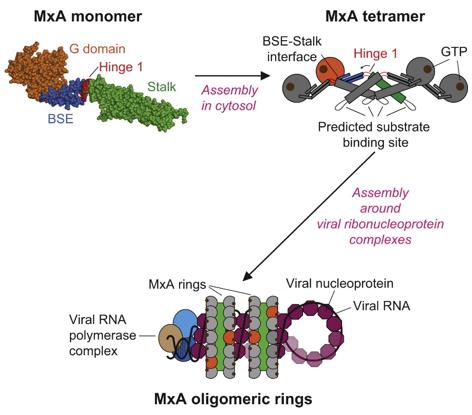What is MX1 Protein
MX1, officially known as Myxovirus resistance protein 1, is a pivotal player in the intricate landscape of cellular defense mechanisms. Also recognized by its synonyms such as MxA and MxB, MX1 belongs to the dynamin superfamily, specifically the large guanosine triphosphatase (GTPase) superfamily. This protein is renowned for its role in the innate immune response, acting as a guardian against viral invasions.
MX1 Protein Structural Characteristics and Classification
Structurally, MX1 is characterized by its unique tripartite domain organization. It consists of an N-terminal GTPase domain, a central bundle signaling element, and a C-terminal stalk domain. This distinctive structure places MX1 in the family of dynamin-like large GTPases.
Recent research in MX1 has illuminated novel facets of its molecular intricacies. Advances in understanding the conformational changes during GTP hydrolysis and the dynamics of MX1 oligomerization have provided valuable insights. Moreover, studies have delved into the interaction between MX1 and viral components, shedding light on the molecular arms race between the host and invading viruses.

Figure 1. Structure of MxA reveals intra- and intermolecular domain interactions required for the antiviral function. (Gao S, et al., 2011)
MX1 Biological Functions and Molecular Mechanisms
The biological functions of MX1 are multifaceted, reflecting its essential role in antiviral defense. Primarily, MX1 operates by disrupting viral replication cycles. Upon viral infection, MX1 is induced and translocates to the sites of viral replication within the cell. By binding to viral nucleocapsids, MX1 inhibits viral transcription and replication, effectively stifling the viral propagation.
At a molecular level, MX1 exerts its antiviral effects through GTP binding and hydrolysis. The GTPase activity of MX1 is pivotal in the formation of higher-order oligomers, a process crucial for its antiviral function. Furthermore, MX1 has been implicated in the modulation of cellular immune responses, acting as a regulator of interferon signaling pathways.
MX1 Related Signaling Pathway
The intricate network of signal pathways involving MX1 underscores its centrality in orchestrating cellular defense responses. MX1 is intricately woven into the fabric of interferon signaling pathways, where it acts as a downstream effector. Upon activation by interferons, MX1 contributes to the amplification of antiviral responses, forming an integral part of the host's defense arsenal.
MX1 Related Diseases
While MX1 is primarily celebrated for its antiviral prowess, alterations in its expression and function have been implicated in various diseases. Studies have linked dysregulation of MX1 to autoimmune disorders, highlighting its involvement in the delicate balance of immune homeostasis. Additionally, aberrations in MX1 expression have been observed in certain cancers, suggesting a potential role in tumorigenesis.
MX1's Applications in Biomedicine
Beyond its fundamental role in cellular defense, MX1 has emerged as a promising tool in biomedical applications. In diagnostics development, MX1 serves as a potential biomarker for viral infections. Its upregulation in response to viral challenges makes it a reliable indicator of ongoing infections, facilitating early and accurate diagnostics.
In the realm of vaccine development, MX1 holds promise as an adjuvant. Harnessing its ability to modulate immune responses, researchers explore its potential to enhance the efficacy of vaccines against viral pathogens. The prospect of MX1 as an immunomodulatory agent opens new avenues in designing next-generation vaccines with heightened protective capabilities.
Moreover, MX1 is being explored for its therapeutic potential. Leveraging its antiviral properties, researchers investigate the development of MX1-based therapeutics to combat viral infections. The prospect of targeted antiviral treatments, inspired by the molecular mechanisms of MX1, offers a novel approach in the battle against infectious diseases.
Recommended Products
| Cat.No. | Product Name | Species | Source (Host) | Tag |
|---|---|---|---|---|
| MX1-603H | Recombinant Human myxovirus (influenza virus) resistance 1, interferon-inducible protein p78 (mouse), His-tagged | Human | E.coli | His |
| MX1-26961TH | Recombinant Human MX1 | Human | Wheat Germ | N/A |
| MX1-321HF | Recombinant Full Length Human MX1 Protein | Human | In Vitro Cell Free System | |
| MX1-491H | Recombinant Human MX1 Protein, Myc/DDK-tagged, C13 and N15-labeled | Human | HEK293T | Myc/DDK |
| MX1-5771H | Recombinant Human MX1 Protein, GST-tagged | Human | Wheat Germ | GST |
| MX1-2785H | Recombinant Human MX1 Protein (Glu366-Thr636), His tagged | Human | E.coli | His |
| MX1-01H | Recombinant Human MX1 protein, His-tagged | Human | Human cells | His |
| MX1-2467H | Recombinant Human MX1 Protein, His-tagged | Human | E.coli | N-His |
| MX1-6629HF | Recombinant Full Length Human MX1 Protein, GST-tagged | Human | In Vitro Cell Free System | GST |
| MX1-646HFL | Recombinant Full Length Human MX1 Protein, C-Flag-tagged | Human | Mammalian cells | Flag |
Reference
- Gao S, et al. Structure of myxovirus resistance protein a reveals intra-and intermolecular domain interactions required for the antiviral function. Immunity. 2011, 35(4): 514-525.

